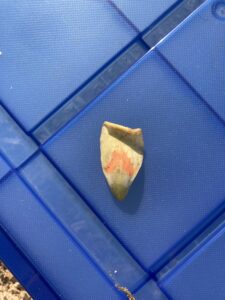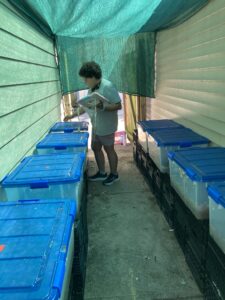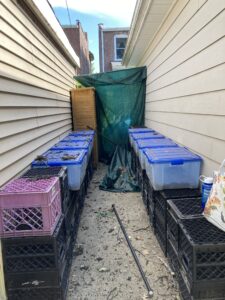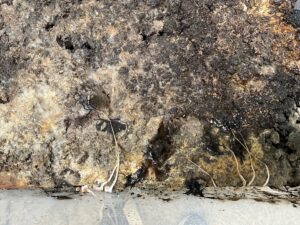Progress report for FNC23-1368
Project Information
Cultivating Bliss Farm is owned and managed by Rev. Gladys Davis. Gladys was a Chaplain prior to transitioning into farming and food production. Gladys, a single mother and survivor of domestic violence, has spent the last 14 years investigating and researching sustainable methods of food production. She began the Cultivating Bliss Farm with a 10ft by 16ft experimental farming plot, testing "straw bale" production of strawberries and asparagus in an urban environment.
Gladys lived in Chicago for 10 years before enrolling in a seminary on the Southside. Her education included an internship in a very small rural community in Eastern Oklahoma. As a Chaplain, she was employed at a transitional housing agency, providing service to homeless mothers and their children who had been in city shelters and were now progressing toward stable housing placement. She provided support to women who literally had nothing but the clothes on their backs and their children.
Gladys has lived and seen, the intentional poverty, in both rural and urban communities, created by systemic-structural oppression and knows the food insecurity wrought by an under funded public assistance program. It is these experiences that transplanted her into the field of food production; seeking the most effective, consistently affordable production methodologies for food equity and justice.
Research on morel production has begun with Dr. Gregory Bonito of Michigan State University LNC19-416: Cultivating a morel mushroom industry in the North Central United States using in-ground rows established in high-tunnel, low-tunnel and forest settings in the North Central Region.
This project seeks to expand on Dr Bonito’s work for potential use in an urban setting, comparing the efficacy of two mediums as substate and the necessity of their sterilization in production. The project will use elevated raceways, placed outdoors, in lieu of in-ground rows, as most urban land contains lead and other contaminants.
Financial constraints remain the major barrier of entry to farming for socially disadvantaged and historically marginalized beginning farmers. This project will compare the
-
Can morels be successfully cultivated in elevated raceways (simulated by elevated totes), making them a viable specialty crop choice for urban vertical stratified production?
-
Can morels be cultivated with minimal start-up expenses, making them a viable choice for socially disadvantaged and historically marginalized farmers?
-
Can morel mushroom production methods be replicated and scaled vertically to generate market level harvests and thereby generate profits?
Our objectives and key questions have not changed, but our design set up has. The original plan is here, for reference. We did not carry out this plan. Our new plan, for 2024, is in the Research methods section.
Plastic milk crates will be stacked on a concrete, two high and 3-4 wide to form a platform. Beds are elevated for ease of observation and harvesting while minimizing ground level contamination. Plywood sheathing panels will be placed atop the milk crates, and covered with a layer of 3mil Black Plastic before lining plot with landscaping fabric to form the base of the plots. The plastic will protect the plywood, extending the functional life of the plots, while the fabric limits erosion. Platforms will be arranged in a North-South orientation, allowing beds to receive the late morning sun, begin receiving shade at 1:00pm with complete shading attained at 2:00pm. Vita 48" W x 48' L White Raised Garden, (with dividers forming 16 quadrants) will be assembled atop the plywood. Two boxes will be assembled and joined, such that, they function as one continuous 4 x 8 foot plot for a total of 4 plots. A utility knife will be use to cut an "X" though the fabric and plastic in the center of each quadrant before a ¼" drill bit will be used to drill a drainage hole; thirty-two holes per plot. Row covers will be constructed using Greenhouse Hoops for Raised Beds and covered with shade cloth. Substrate sterilization is completed in a 100L Atmospheric Steam Sterilizer according to operation specification.
Morchella sextelata sawdust spawn will be obtained from Dr. Gregory Bonito of Michigan State University. Each plot will be inoculated from its own dedicated spawn block to avoid cross contamination. Investigator will wear sterile neoprene gloves and inoculate each quadrant of the plot with spawn to a depth of 4 inches in 9 evenly spaced sites via Inoculation Stick. After inoculation, substates will be covered using a layer of Scotts Premium Top Soil to a depth of 2 inches and a layer of black plastic sheeting will be laid over the soil.
- Plot #1 will have a substrate of purchased Mushroom Media Masters Mix. The 20 pound bags will be mixed with filtered water, to the desired consistency (hand squeeze method) and Sterilized according to equipment specifications before being placed in plot.
- Plot #2 will have a substrate of purchased Mushroom Media Masters Mix. The 20 pound bags will be mixed with filtered water, to the desired consistency (hand squeeze method) Unsterilized.
- Plot #3 will have a substrate of Sterilized mixed wood chips obtained from the St Louis Department of Forestry, "Free" mulch site in Carondelet Park.
- Plot #4 will have a substrate of mixed wood chips obtained from the St Louis Department of Forestry, "Free" mulch site in Carondelet Park. Unsterilized
One filtered water drip irrigation system will be installed to supply all 4 plots. Plots will be monitored for moisture levels and observe growth changes. Beds will be maintained between 50-60% moisture content. The black plastic row cover sheeting will be used for protection and to contain moisture during the formation of conidia. Small slits will be made every 3 feet for ventilation. 2-3 weeks post inoculation, sterile "Nutrient bags" will be cut once using a sterile knife. Bags will be placed, cut side against the soil, every 2 feet in each plot. At this stage, the plastic sheeting cover will be replaced by hoops covered with shade cloth for improved ventilation while providing ongoing protection from contamination and predation.
Project Objective: compare fruiting body development on substrates to determine 1) which substrate produces the highest yield with the lowest production cost and 2) which substrate has commercial production viability, determined by reproducibility and scalability.
Research
Summary of Year One: 2023
Due to circumstances beyond my control the location of the project, as written in the grant proposal, is no longer accessible. An alternate urban location for the research has been secured, and our budget has been updated significantly to match the new scale and set up of our
We are adjusting to the new reality of our project being in an urban backyard setting rather than the original urban farm property. Instead of growing mushrooms in four raised beds, it’s now 8 totes. We will compare 8 treatments.
- Treatment 1: Master’s Mix substrate – Sterilized – With Added Nutrients
- Treatment 2: Master’s Mix substrate – Unsterilized - With Added Nutrients
- Treatment 3: City mulch – Sterilized - With Added Nutrients
- Treatment 4: City mulch – Unsterilized - With Added Nutrients
- Treatment 5: Aged Tulip poplar mulch – Sterilized - With Added Nutrients
- Treatment 6: Aged Tulip poplar mulch - Unsterilized - With Added Nutrients
- Treatment 7: Northspore Bulk Substrate - With Added Nutrients
- Treatment 8: Northspore Bulk Substrate – No Additional Nutrients
These 8 trials will allow us to investigate the following questions about growing morels in an urban setting:
- Do morels need the fortified, sterilized soil mix?
- Can the city mulch suffice, without being sterilized?
- Do morels need the nutrient mix?
In summary: Can you grow morels with only basic supplies and materials, or are commercially prepared and higher cost items required for success?
Notes:
- For the city mulch treatments, we will include compost and topsoil.
- Totes will be positioned between two garages, receiving full sun from 11:30am-1:30pm.
- Once temperatures consistently reach 80 degrees, we will move them to below a deck, to simulate forest floor temperature. We will also compare single species (tulip poplar) mulch, sterilized and unsterilized.
- In theory, the sterilized trials of Master’s Mix and Northspore should produce on their own. However, we will investigate if the nutrient solution improves outcomes.
We will quantify our results by recording data daily on:
- Mushroom growth
- Soil temperature, moisture, pH
- Temperature under the deck
We will also compare the treatments based on “cost to serve” – meaning, how much did it cost to get that amount of mushrooms to the customer?
Summary of Year One: 2023. To date no results have been achieved.
YEAR: 2024
We began this experiment by following sanitation procedures from my experience in commercial kitchen sanitation in conjunction with Dr Bonito’s procedures.
- 12 holes were drilled in each of the 8 totes, using a 1/4 drill bit
- (3) holes on each side
- (2) on each end and
- (2) on the bottom for drainage.
- While the number of holes was sufficient, their small size limited air exchange and supported the growth of mold and algae.
- The “city mulch” used in totes 3 & 4 was freshly cut tulip poplar as evidenced by the flower petals within the pile.
 Petal found in the small pile of freshly ground mulch
Petal found in the small pile of freshly ground mulch
- We were unable to move totes under decking to simulate shaded woodlands. To compensate, we purchased 70% shade cloth as a substitute. After numerous attempts it was concluded that the shade cloth would not remain in position given our limitations of using property and space we did not own.

Shade cloth use  .
.
As a result totes were adversely impacted by extremely high temperatures and challenges with humidity levels. - We completed the new setup and configuration at the end of May. Owing to an unusually long cool spring, we chose to induce pinning in early June, past morel season in Missouri. Nutrient packs were no longer available to us through Dr Bonito. We induced pinning by adding 1 tablespoon fresh cedar wood ash to 1 cup distilled water, (simulating a forest fire and spring rain) omitting and sugar substances from the solution. We observed what we believe to be the initial stage of a morel pinning. However, before it matured, Missouri experienced 3 consecutive days of extreme heat advisories; temperatures over 90 degrees before 10am. Whatever developed, was never observed.
- The change in location made daily data collection and observations impossible.
Educational & Outreach Activities
Participation Summary:
No official outreach activities.
*At various times during the season, curious neighbors stopped by to see the experiment and observe our conducting tests and collecting data. Each person had their own set of questions and received our information and hopes with enthusiasm.
Learning Outcomes
In hindsight:
- …we would use a high speed drill to avoid cracking the plastic and getting a “clean” hole.
- …we would use at least a 1inch bit and cover holes with a filter patch or surgical tape for cleaner air flow.
- …we would throughly sanitize the plastic covering with a liberal amount of 70% isopropyl alcohol.
- …we learned, as with farming in general and with the shade cloth in particular, that occasionally there are unforeseen circumstances that occur which can not be overcome.
- …when temperatures began to rise, the totes needed to be moved to a climate controlled indoor environment, which was not available to us.
- … pinning should have been triggered earlier in the season or under increased climate controlled conditions.
One challenge we faced was, the advancement in mushroom production in the commercial industry from the time the grant was written until it was approved. It is now possible to purchase a fully automated, climate controlled “br-oom box” (a tote designed specifically for mushroom production). This product can easily be purchased; including accessories, spawn, shipping and handling your total investment would be around $200 (USD).
This product is highly adaptable, allowing for safe production of mushrooms in your family’s living space. It eliminates the dangers associated with spores released in to a home’s indoor atmosphere…which prevented our movement to an indoor environment.
We attended Cornell University’s online class “BF 153: Indoor Specialty Mushroom Production”. This college course was invaluable! The instructors have thought of everything and the format is easy to follow, self-paced (stopping to allow time to digest information, then continuing) and can be repeated as often as desired.
Project Outcomes
There are no concrete numbers for changes or outcomes. However, 10 families have been exposed to idea of at-home mushroom cultivation. These are urban families who were previously oblivious to the concept. 2 of these families have children who have identified as vegetarian. Both families shared their frustrations with not being able to find mushrooms and once found, they were stunned by the price.
